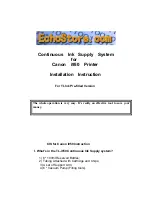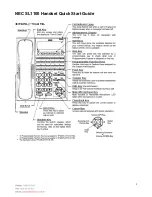
1. Soak the WATERMARK sensor in water before installation.
Always install a “wet” sensor.
2. Locate a representative spot in an area of the landscape that
will determine if irrigation is necessary. This area should be
evenly watered by the sprinklers with good sun exposure.
3. Cut out a small section of soil exposing the roots. (Figure 1)
4. Excavate a hole about 3'' to 6'' deep for the sensors to be
installed. If the soil is hard, use
a piece of 1/2'' pipe to make an
access hole. Fill the bottom of
the hole with a thick slurry
made of soil removed from the
hole and water, then firmly
push the sensor down into the
mud in the bottom of the hole.
This will “grout-in” the sensor to
ensure maximum surface
contact between the sensor surface and the surrounding soil.
Alternately the sensor can be firmly pushed to the bottom of
the access hole as long as it is a tight enough fit to ensure
adequate contact. A snug fit is absolutely necessary. Insert the
sensor into the root area at a 45° angle. (Figure 1). Pack the
soil tightly around the sensor.
Note: Sensors must be firmly contacting
the soil within the root area.
5. Dig a narrow trench to route the sensor wires back to the
controller location.
6. Splice the sensor wires on to additional wire
INSTALLATION AND OPERATING INSTRUCTIONS
Soil Moisture Sensor and Switch
Automates your Irrigation Controller
to Water ONLY when Necessary
For Residential use in landscape with any 24 volt AC
irrigation controllers with sensor (rain switch) connections.
View the WaterSwitch Installation video at:
www.IRROMETER.com
1
FIGURE 1
(minimum AWG 18-2 UF direct burial type) as needed with
enclosed waterproof wire connectors to go all the way back
to the controller location.
7. Backfill the trench to bury the wire.
8. Mount the WaterSwitch module next to or inside the
irrigation controller. Cut out the Quick Reference Card and
attach nearby so anyone servicing the system will know it
is moisture controlled.
9. Attach switch wires to the sensor connections on the
controller (may be labeled rain sensor) (Figure 2). Brown &
Yellow = closed switch to irrigate, Blue & Yellow = open
switch to irrigate.
Note: The WaterSwitch, a rain switch and a freeze switch
can all be wired in series to the sensor connections (see
diagram on back).
10. Attach Black and White power wires to the 24 Volt AC
supply connections from the transformer (Figure 2). Attach
sensor wires (Green) to the wires coming from the sensor
in the lawn.
11.
Be sure the area where the sensor is located is irrigated
by the last valve to operate. You may have to change the
sequence of the valves in order to water this area last.
(All valves must have the opportunity to be watered
before the area where the sensor is located is watered).
12. Select a moisture setting representative for your lawn (see
Quick Reference Card). When selecting a moisture setting,
always pick a wetter setting and observe the landscape for
at least two irrigation cycles before adjusting up to a drier
setting. If dry spots appear in the lawn, adjust the sprinklers
to give more uniform coverage. If the entire lawn appears
dry, then select a wetter moisture setting.
2
Instructions for using enclosed wire connectors:
IMPORTANT
:
Turn off power before installing or removing connector.
Product to be used in accordance with local
and national codes.
a. Strip #22 - 18 wires 1/2'' (12.7 mm)
and #16 - 12 wires 3/8'' (9.5mm).
b. Align any frayed strands or conductors.
c. Pretwisting is unnecessary. Place
stripped wires together with ends of
insulation even.
d. Twist connector onto wires pushing
firmly until hand-tight. Do not over
torque.
e. Wipe sealant in and around
conductors and connector opening
while tightening.
Do not reuse.




















